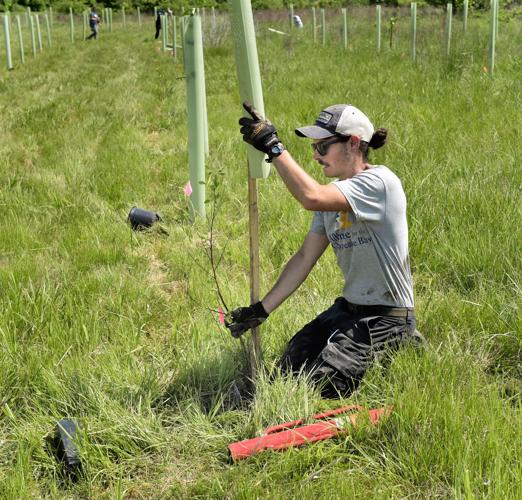Ryan Davis took a break, setting down his tools where he worked Friday morning on the grassy banks of a Manheim Township stream that cuts through Overlook Park.
There, he pointed to colleagues equipped with shovels and augers they used to dig holes that would soon be planted with hundreds of shrubs and trees.
The idea, Davis said, is that those plants will grow to form a forested area -- called a riparian buffer -- adding a layer of pollution protection along the stream.
In fact, the project fits with a larger goal in Lancaster County to install 6,000 new acres of riparian buffers by 2025.
That’s according to Allyson Ladley Gibson of Lancaster Clean Water Partners, a group of conservation-focused organizations working to clean the county’s impaired streams.
Friday’s planting was organized and implemented by the Clean Water Partners, with volunteers from more than a dozen partner organizations putting plants in the ground.
That type of collaboration on a single project is somewhat unusual and should be celebrated, said Ashley Spotts, a restoration specialist at Chesapeake Bay Foundation.
“It’s the first of hopefully many,” Spotts said, as she stood in the project area Friday.
As leaders of the partners’ Buffer Action Team, Spotts spearheaded Friday’s planting alongside Davis, a forest program manager with the Alliance for the Chesapeake Bay.
The goal for the day, Davis said, was to install about 550 plants over about 2.5 acres, with a plan to eventually return, hopefully planting an 8 acre space by the end of the year.
The work cost several thousand dollars, with organizers able to utilize some unused grant funding from other projects, as well as leftover materials, he said.
Township officials approved the planting, a spokesman said.
All of the plants installed are native to Pennsylvania, Davis said, adding the buffer will be made up of well over a dozen plant species.
Buffers can help capture and soak up pollutants carried by stormwater before they enter streams while also helping to promote healthy in-stream conditions, Davis said.
Gibson, the partners’ strategic partnerships and programs director, elaborated.
“The plants serve as an extremely good filter and sponge for water running off during a light sprinkle or a flash storm,” she said.
It’s just one conservation practice necessary for the partners to achieve their goal of cleaning all Lancaster County waters by 2040 -- a tall task with more than half of the county’s 1,400 miles of streams currently considered impaired.
The project also will help to meet a countywide mandate from federal regulators to remove harmful sediment and nutrients, nitrogen and phosphorus, from the local waterways. Those pollutants harm local waterways, as well as downstream locations like the Susquehanna River and the Chesapeake Bay.
“Once fully planted, the planting should remove about 211 pounds of nitrogen, 9 pounds of phosphorus and 12,500 pounds of sediment per year,” said Kristen Koch, a program manager with Penn State Agriculture and Environment Center.
On Friday, those working to install the plants were clearly visible from Granite Run Drive, where it cuts through the park, which was packed with golfers, runners and other recreation-seekers.
Organizers were hopeful that parkgoers would notice the work, possibly inspiring new interest in conservation, said Lauren Shaffer, an agricultural outreach specialist with Penn State Agriculture and Environment Center.
“It’s highly visited, highly visible,” Shaffer said. “That is definitely a benefit to planting in an area like this.”







 SEAN SAURO | Staff Writer
SEAN SAURO | Staff Writer
